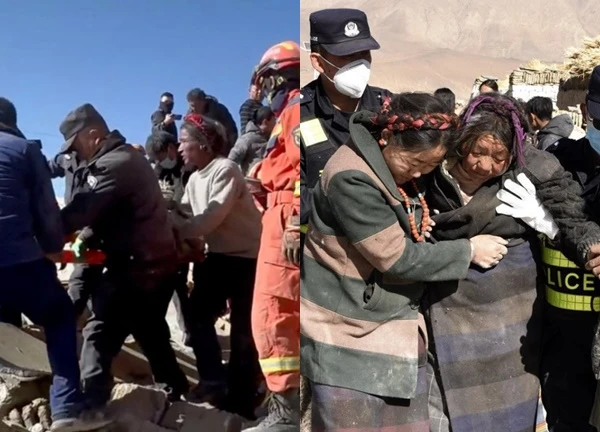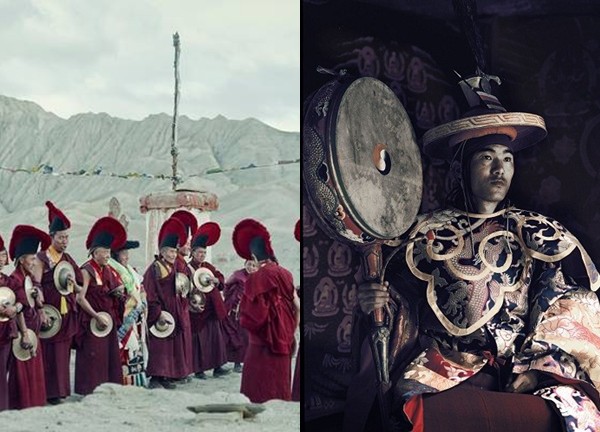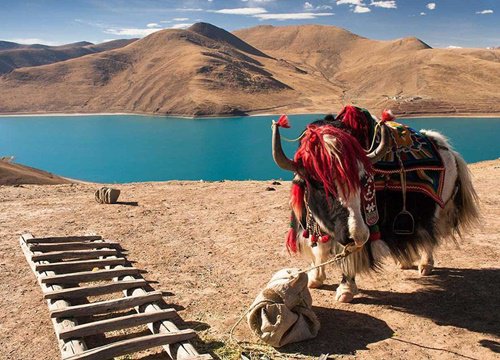China: The epidemic is not over, a terrible earthquake occurred, destroying 1 village

1 | 0 Discuss | Share
Cooking rice at high altitudes, especially at 5,000 m, is a major challenge due to low air pressure. At sea level, atmospheric pressure is about 1 atm (101,325 Pa), causing water to boil at 100°C.
But as altitude increases, pressure decreases, causing the boiling point of water to decrease. At 5,000 m, atmospheric pressure is only about 0.54 atm, causing water to boil at about 83°C. This temperature is not enough to soften the rice, resulting in the rice not being fully cooked.
This phenomenon is explained by the physical principle of saturated vapor pressure. When atmospheric pressure is reduced, water molecules require less energy to change from liquid to vapor. Therefore, water boils at a lower temperature. In fact, physical experiments have shown that water can boil at room temperature if placed in a vacuum environment, similar to what happens in high mountains.
The change in boiling point with altitude has been well documented. At 1,000 m, water boils at about 96.8°C; at 3,000 m, the boiling point drops to 90°C; and at 5,000 m, it drops to just 83°C. At higher altitudes, such as Mount Everest , which reaches 8,848 m, water boils at 70°C. This temperature is not high enough to kill bacteria in the water or fully cook many foods.
This situation poses a great challenge for people and explorers in high altitude areas. To cope, the pressure cooker becomes an effective solution. The pressure cooker increases the pressure inside the pot, allowing the water to boil at a higher temperature, thereby making rice softer and food more thoroughly cooked. This is an indispensable tool for families living in high altitude areas and mountain climbers.
People in highland areas often develop special cooking techniques to adapt. In Tibet, they use barley instead of rice, because barley cooks more easily at low temperatures. In the highlands of Vietnam, people often steam or stew their food for a long time to ensure that it cooks evenly. Some people also roast the rice before cooking to reduce the softening time.
Cooking rice is not the only challenge, as is boiling water for drinking. In low-pressure areas, boiling water is not hot enough to effectively kill bacteria, forcing people to use additional disinfection methods such as water purification tablets or boil water for longer periods of time.
These challenges also affect climbers and explorers. Carrying pressure cookers or using easy-to-prepare foods such as dry noodles has become a popular choice. Meanwhile, modern appliances such as electronic pressure cookers or specialized high-altitude stoves are being developed to improve cooking conditions in these places.
Experimental records show that even at low boiling points, water can evaporate faster at high altitudes. However, this does not bring much benefit in cooking, but only makes dehydration easier. To overcome this, local people and scientists are constantly looking for solutions to adapt to the harsh environment of high mountains.
So, can you only eat raw rice in the mountains? Of course not. People have invented a pressure cooker that is suitable for cooking rice in this situation.
There is a screw on the lid of the pot, inside there is a rubber gasket, when the screw is tightened, the lid will cover the pot tightly to prevent steam from escaping. Using a pressure cooker to cook rice, the steam has no way to escape, when the pressure in the pot reaches the atmospheric pressure of 1,013 bar, the boiling point of water will be equal to that at the foot of the mountain, the rice can be cooked.
Currently, the pressure cookers sold on the market usually control the pressure at about 2.2 atmospheres, the highest temperature the pot can reach is 123 degrees Celsius. Using this type of pressure cooker to cook rice and food saves both fuel and time.
Similarly, people have challenged themselves to boil an egg on Mount Everest. Because the boiling temperature of water changes with altitude, the egg white and yolk will not be able to cook completely if boiled on the top of Mount Everest, which is 8,849 m high.
Eggs can be soft-boiled or hard-boiled almost anywhere on the planet, but not at the highest point on Earth, Mount Everest. This may not be a pressing issue, but the thermodynamics behind this fact affect how both food and drink are prepared in many parts of the world, according to IFL Science.
With Mount Everest, the problem is air pressure. At sea level, water boils at 100 degrees Celsius. That's the boiling point. As the pressure changes, the boiling point changes. The higher you go above sea level, the lower the temperature required for water to boil.
You can use a calculator to work out the exact boiling point where you are, but roughly for every 300m increase in altitude, the boiling point drops by one degree Celsius. The town of La Rinconada on Mount Ananea in the Peruvian Andes is the highest permanently inhabited place in the world (5.52m). There, water boils at 82.8 degrees Celsius.
The summit of Mount Everest is much higher than the town of La Rinconada, at 8,849 metres above sea level, and the pressure is about one-third that of the atmosphere. As a result, the boiling point of water there drops to 68 degrees Celsius. That’s still hot enough to cause serious burns, but not hot enough to fully boil an egg.
Both egg whites and yolks are made of different compounds and proteins coagulate at different temperatures. The whites, which are 54% ovalbumin, do not coagulate until they reach 80°C, while the yolks need at least 70°C to harden. The temperature of boiling water will not be enough to cook an egg.
If you're on top of Mount Everest and really craving boiled eggs, the only solution is to use a pressure cooker. That cooking method increases the boiling point by increasing the pressure inside the pot.
Trieu Lo Tu actively does charity work, has fully recovered, is about to return to showbiz?  Nguyễn Tuyết16:15:50 11/01/2025After sharing her recovery vlog, Trieu Lo Tu almost disappeared from social media. However, the actress's health status is always updated to her fans.
Nguyễn Tuyết16:15:50 11/01/2025After sharing her recovery vlog, Trieu Lo Tu almost disappeared from social media. However, the actress's health status is always updated to her fans.

1 | 0 Discuss | Share

5 | 1 Discuss | Share

3 | 0 Discuss | Share

3 | 0 Discuss | Share

4 | 0 Discuss | Share

1 | 0 Discuss | Share




5 | 0 Discuss | Report